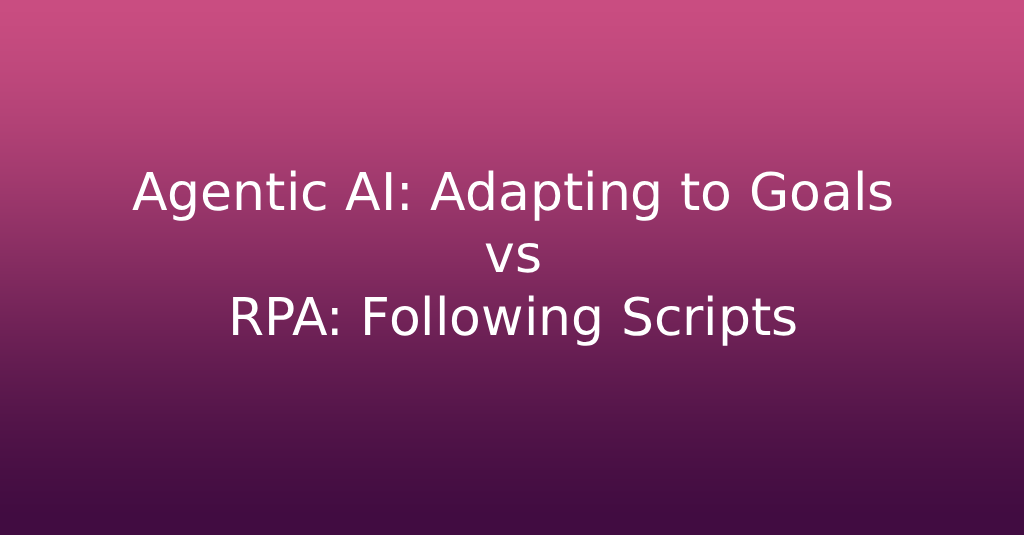Escrito por: Ernesto Molina Publicado: 24/10/2025
Enterprises are trying to automate everything today, and the technical landscape is being changed by Agentic AI and RPA (Robotic Process Automation). RPA works with exact, predefined instructions. While Agentic AI can aim to reach this goal, it plans and executes a sequence of tasks with minimal human intervention.
The potential of both approaches is huge. Many industries, including finance, insurance, healthcare, and customer service. These are already adopting Agentic AI in their internal systems to solve complex problems.
Both are trying to automate repetitive work and improve efficiency, but they achieve it in very different ways.

Agentic AI refers to an autonomous AI system. It can operate independently to achieve complex, long-term goals without constant human involvement. Agentic AI can understand its environment, reason, plan, act, and learn from its actions to become more efficient.
Robotic Process Automation (RPA) uses software bots to act like a human on a computer. It follows a predefined script-based path to complete tasks when working with digital systems. RPA systems allow enterprises to reduce errors and speed up operations while maintaining quality
The two approaches reflect different philosophies of automation:
Agentic AI on adaptive goal achievement, while RPA focuses on the strict execution of predefined steps.
| Aspect | RPA | Agentic AI |
|---|---|---|
| Primary role | Executes predefined tasks | Achieves goals autonomously |
| Nature | Scripted, rule-based | Reasoning-driven, adaptive |
| Input needed | Step-by-step instructions | Clear goal or outcome |
| Flexibility | Brittle to change | Adjusts dynamically |
| Data | Structured only | Structured and unstructured |
| Maintenance | IT-heavy | Self-adjusting with guardrails |
| Business value | Efficiency in stable processes | Efficiency and scalability in complex processes |
Agentic AI and Robot Process Automation, despite their differences, share some core similarities:
Hyperautomation is the moment robotic process automation, AI, machine learning, and analytics fuse into one. RPA, being the “muscle”, works along with agentic AI as a “brain” to streamline business processes and provide better customer interactions.
Hyperautomation is all about strategy and orchestration. Taking the right decision on what to automate with RPA and what to leave to the agentic AI. Chaining processes together for improved problem solving workflows.
Automation itself is incredibly useful, but when you step into the fields of overautomation, it can become a burden.
Overautomation is when a business automates tasks and processes that actually do not need AI-driven workflows. Often, overautomation creates ineffectiveness and leads to a bad customer experience.
Overautomation can hurt customer experience by making customers feel detached and dealing with machines. As a consequence, this may lead to poor customer satisfaction and loyalty. Systems become unstable, difficult to maintain, and improve.
Depending on your organization, other factors may shift your decision as well.
In short, the answer is no!
AI agents are a long way from destroying RPA. For some time, they will operate together, and the RPA will be maintained on a large scale, with non-decision-making processes. Because of its stability and auditablility. As the AI agents progress, they will gradually replace RPA for more complex processes, where decisions are needed at any stage of the flow.
Success with Agentic AI depends on addressing challenges such as reliability, oversight, and transparency. At Maisa, we are building Digital Workers with accountability at their core. They are designed to reason clearly, act consistently, and explain their decisions. This way, businesses can scale automation with confidence.
RPA delivers fast, stable, rule-based processes, while Agentic AI opens the door to automating more complex and adaptive workflows. The change marks a move from following predefined scripts to achieving outcomes with autonomy.